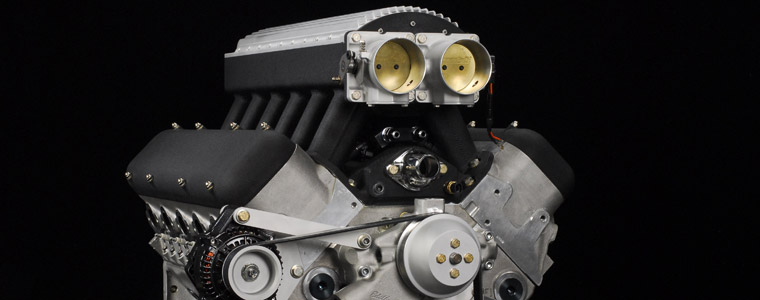Building, designing and developing race-winning engines for over 50 years

Falconer V12 FAQ
If you don't see the question you're looking for, click here to let us know.
- Who manufactures the Falconer V12?
- The Falconer V12 is manufactured by Ryan Falconer Industries, Inc. Ryan Falconer Racing engines handles the assembly and R&D for the Falconer V12.
- Is the Falconer V12 just two blocks welded together?
- Absolutely not. The block, crank girdle, heads, valve covers and intake manifold are dedicated castings. These parts are cast aluminum, although a cast magnesium intake manifold was produced for aviation variants of the Falconer V12. Only the prototype engine was constructed by welding the necessary components together.
- What displacements are available with the Falconer V12?
- Displacements can range from 400 to 600 cubic inches (6.5 to 9.8 liters).
- Can the Falconer V12 be equipped with carburetors?
- No. Carburetors are nowhere near as efficient as electronic fuel injection. All Falconer V12 engines use MoTeC engine management systems.
- Does the Falconer V12 have wet sump or dry sump oiling?
- The Falconer V12 now only comes with dry sump. Using a 7-stage Bill Dailey Engineering oil pump and a specially-designed billet aluminum sump (the HVSS or High Volume Separate Scavenge) we have optimum oil control. The dry sump system used on the Falconer V12 is available for standard and reverse-rotation variants of the engine.
- Can the Falconer V12 be equipped with a wet sump oiling system?
- No. Dry sump configuration is all that is offered for the Falconer V12.
- Is the Falconer V12 based on a Small-Block or Big-Block Chevy?
- The Falconer V12 is, and always has been based on a Small-Block Chevy.
- What is the block angle of the falconer V12?
- The block angle of the Falconer V12 is 90-degrees, the same as a Small Block Chevy.
- I thought the block angle for a V12 had to be 60-degrees?
- This is a popular misconception. Block angle does affect the crankshaft design, but any V engine can have any block angle. Formula 1 engine design has shown a variety of block angles, some that end on half a degree. Wider block angles, such as 90-degree, offer an engine shorter in height, narrower block angles yield a taller engine (measured from crank centerline to the top of the engine).
- Is the Falconer V12 smog legal?
- No. However, with some additional redesign and modification it could be, although the only reason for this would be for mass-production for use in supercars, etc.
- Does the Falconer V12 have overhead cams?
- No. the Falconer V12 is a single camshaft pushrod engine, the same as a Small Block Chevy.
- Can I get the Falconer V12 in reverse rotation?
- Yes. We have built reverse-rotation variants of the Falconer V12 for use in aviation.
- Is the Falconer V12 all aluminum?
- Yes.
- How much does the Falconer V12 weigh?
- This varies based on the overall configuration. As a general rule, a naturally-aspirated variant of the Falconer V12 weighs in around 500 pounds (226.8 kg).
- Can the Falconer V12 be equipped with turbochargers or superchargers?
- Absolutely. We have built Falconer V12 engines with up to 4 turbochargers, others with two superchargers.
